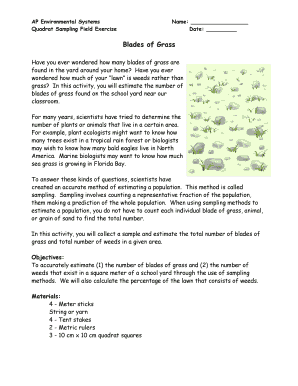Loading

Get Quadrat Worksheet
How it works
-
Open form follow the instructions
-
Easily sign the form with your finger
-
Send filled & signed form or save
How to fill out the Quadrat Worksheet online
The Quadrat Worksheet is a crucial tool for estimating the number of blades of grass and weeds in a designated area. This guide aims to provide you with clear, step-by-step instructions on how to accurately complete the worksheet online.
Follow the steps to fill out the Quadrat Worksheet seamlessly
- Click 'Get Form' button to obtain the Quadrat Worksheet and open it in the designated editor.
- In the 'Name' field, enter your name. This identifies your work on the worksheet.
- In the 'Date' section, input the current date to document when the sampling was conducted.
- Locate the section titled 'Data Collection.' Here, you will need to find the Quadrat Number and fill it out accordingly.
- For each sample location, record the number of blades of grass and the number of weeds in the spaces provided under the 'Data Collection' section.
- After recording the data for three different quadrat samples, calculate the average number of blades of grass and weeds. Document these averages where indicated.
- Proceed to estimate the total number of blades of grass and weeds in one square meter by multiplying the averages by 100. Write these estimations in the respective spaces.
- Calculate the total number of plants by adding the total number of blades of grass to the total number of weeds and record this in the space provided.
- Determine the percentage of weeds by dividing the estimated total number of weeds by the estimated total number of plants, then multiplying by 100. Insert this percentage in the designated area.
- Review all entered information to ensure accuracy before proceeding. You have the option to save your changes, download, print, or share the form.
Complete your Quadrat Worksheet online today and enhance your understanding of sampling techniques.
The quadrat equation uses the population density to calculate the estimated total population or N: N = (A/a) x n, where A is the total study area, a is the area of the quadrat, and n is the population density.
Industry-leading security and compliance
US Legal Forms protects your data by complying with industry-specific security standards.
-
In businnes since 199725+ years providing professional legal documents.
-
Accredited businessGuarantees that a business meets BBB accreditation standards in the US and Canada.
-
Secured by BraintreeValidated Level 1 PCI DSS compliant payment gateway that accepts most major credit and debit card brands from across the globe.


